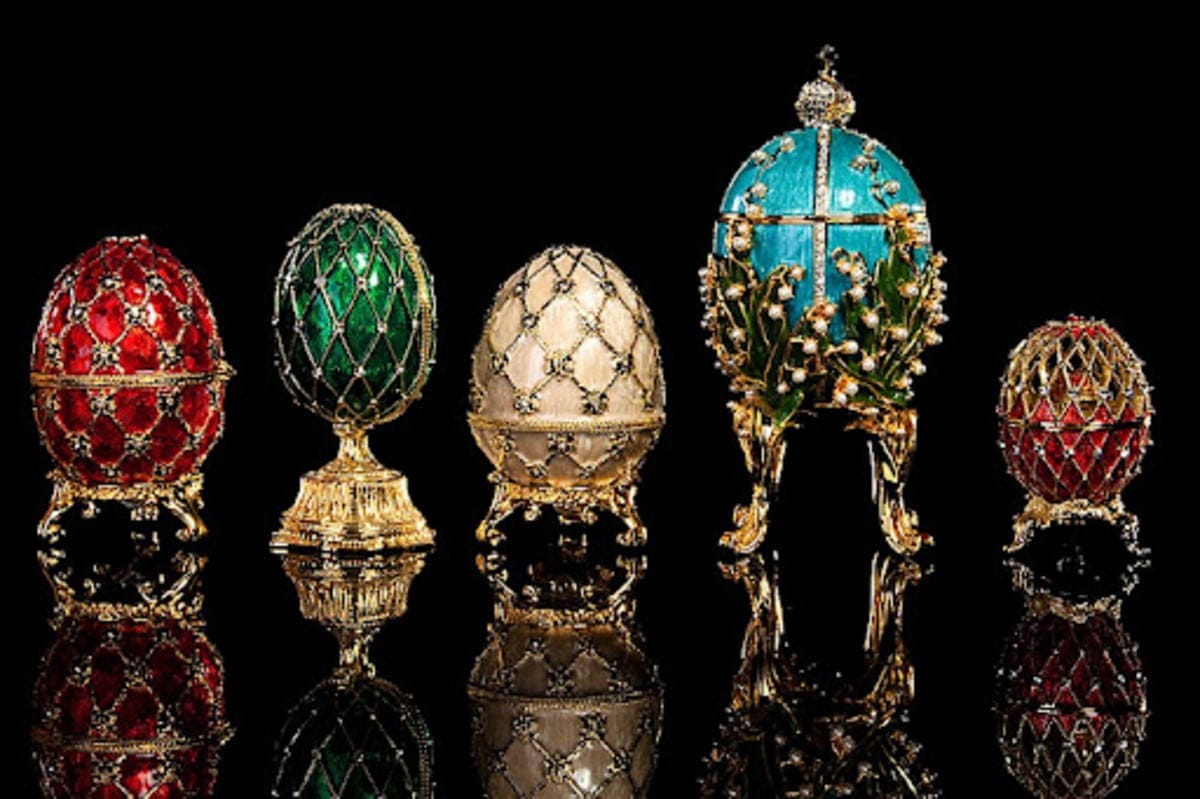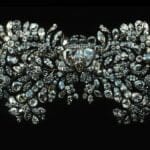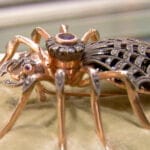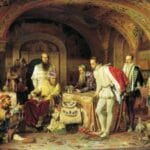Hey there, art enthusiasts! Get ready to dive into the captivating world of lost Fabergé masterpieces. These aren’t your ordinary lost treasures; we’re talking about exquisite pieces crafted by the renowned House of Fabergé, shrouded in mystery and steeped in history.
Lost Fabergé Masterpieces: A Glimpse into a Bygone Era
Imagine a world of dazzling diamonds, shimmering gold, and secret compartments revealing intricate treasures – that’s the magic of Fabergé. These weren’t merely beautiful objects; they were symbols of power and prestige, meticulously crafted for the Russian Imperial family.
But here’s the catch: some of these treasures have vanished, leaving behind a trail of unanswered questions and tantalizing clues. Experts believe that several Fabergé masterpieces are out there, lost to time and circumstance. These missing pieces represent gaps in our understanding of art history and the lives of those who possessed them.
What Happened to the Missing Treasures?
Theories abound regarding the fate of these lost masterpieces. Some speculate they were hidden during the tumultuous Russian Revolution, their locations lost amidst the chaos. Others propose they were secretly sold or smuggled out of Russia, their provenance obscured to protect the sellers.
The possibility of their destruction also looms, as even precious objects can fall victim to accidents, theft, or the ravages of time. The mystery persists, captivating researchers and art historians who tirelessly pursue leads, pouring over old records, and employing modern technology to unravel the enigma of the lost Fabergé masterpieces.
The Elusive Seven: Fabergé Eggs Lost to Time
Out of the 52 dazzling Easter eggs crafted for the Russian royal family, seven remain lost, each with a captivating story waiting to be unearthed. Here’s a glimpse into these enigmatic treasures:
- The Hen with Sapphire Pendant (1886): This egg is shrouded in the most mystery, with no known pictures or detailed descriptions. Its very existence is debated among experts.
- The Cherub with Chariot (1886): Believed to have been spirited away from St. Petersburg during the Russian Revolution, this egg’s final destination remains unknown.
- The Nécessaire (1889): Despite its significance as a meticulously crafted work of art, the Nécessaire egg remains elusive, its whereabouts a mystery.
- The Mauve (1897): This egg’s vibrant purple enamel makes it particularly intriguing, leading some to believe its unique appearance could hold clues to its current location.
- The Royal Danish (1903): You’d think an egg made for royalty would be easier to track, but this one has also vanished.
- The Alexander III Commemorative Egg (1909): Created to honor the late Tsar, this egg disappeared during the upheaval of the Russian Revolution.
The search for these lost eggs continues, fueled by the thrill of the unknown. They could be tucked away in private collections, hidden in plain sight, or lost to history forever.
How many Fabergé eggs are still missing?
The mystery of the missing Fabergé eggs continues to captivate art enthusiasts and history buffs alike. Of the 52 Imperial eggs commissioned by the Romanov dynasty, seven remain lost to this day, their whereabouts a subject of much speculation and intrigue.
The Missing Eggs:
- Hen with Sapphire Pendant (1886): One of the earliest eggs, believed to contain a tiny diamond hen.
- Renaissance Egg (1894): Inspired by the art of the Renaissance period.
- Coronation Egg (1897): Crafted to commemorate Tsar Nicholas II’s coronation, likely adorned with lavish jewels.
- Alexander III Equestrian Egg (1904): Honoring Tsar Nicholas II’s father, potentially featuring a miniature horse and rider.
- Standart Yacht Egg (1907): A tribute to the Tsar’s opulent yacht.
- Third Imperial Egg (1887): Even its appearance remains largely unknown.
The fate of these missing treasures is uncertain. Some theories suggest they were destroyed during the Russian Revolution, while others believe they are hidden away in secret collections, waiting to be rediscovered. The possibility, however slim, is enough to keep historians and treasure hunters dreaming of the day these lost artifacts might resurface.
Are there any Fabergé eggs left?
Despite the mystery surrounding the missing eggs, a significant number of Fabergé Eggs still exist, captivating art enthusiasts around the world. Of the 50 exquisite eggs created for the Russian royal family, 43 are accounted for, offering a glimpse into the artistry and opulence of a bygone era.
The whereabouts of the remaining seven eggs remain unknown. Some speculate they were lost or destroyed during the Russian Revolution, while others believe they were sold by the Bolsheviks to fund their new government. The possibility that some might be tucked away in attics or hidden vaults continues to fuel treasure hunts and capture imaginations.
The discovery of a lost Fabergé egg in 2015, valued at $33 million, reignited hope for the recovery of other missing treasures. The search continues, driven by the allure of the unknown and the potential to uncover more of these exquisite creations.
Key Takeaways:
- Out of the 50 Fabergé eggs crafted for the Russian royal family, only 43 are currently accounted for.
- The location of the remaining seven eggs, including the “Hen Egg with Sapphire Pendant,” remains a mystery.
- Discoveries like the Rothschild Egg fuel hope that more missing eggs might be found.
- The mystery surrounding these missing treasures continues to intrigue collectors and historians alike.
Are there any Fabergé eggs in the USA?
While the largest collection of Fabergé eggs resides at the Fabergé Museum in St. Petersburg, Russia, the USA boasts a surprising number of these dazzling treasures. Out of the 69 known Fabergé eggs, 52 were Imperial Easter Eggs, specifically created for the Russian Tsars, making their presence in the US even more remarkable.
Notable Collections:
- Virginia Museum of Fine Arts (Richmond): Holds the largest collection outside of Russia, with five Fabergé eggs.
- Metropolitan Museum of Art (New York City): Displays three Fabergé eggs.
- Hillwood Estate, Museum & Gardens (Washington, D.C.): Houses two Fabergé eggs.
- Cleveland Museum of Art (Ohio): Proudly displays one of these intricate creations.
The mystery of the seven missing Imperial Easter Eggs adds another layer of intrigue. Some believe they were destroyed during the Russian Revolution, while others speculate they may reside in private collections, their existence unknown to the world.
The hunt for these lost masterpieces continues to fascinate historians, art enthusiasts, and anyone who loves a good mystery. The allure of the unknown and the exquisite beauty of Fabergé’s creations fuel the search for these lost treasures.
What is the Most Important Fabergé Egg?
Among the stunning array of Fabergé eggs, the Winter Egg from 1913 stands out as perhaps the most significant, both in terms of its value and historical importance.
A Gift Fit for a Tsarina:
Tsar Nicholas II commissioned this lavish egg as a gift for his mother, Marie Feodorovna. Crafted from gold and platinum and adorned with glittering diamonds, the Winter Egg sits upon a base of crystal-clear rock crystal. Inside, a tiny basket of lilies-of-the-valley, also crafted from gold and precious stones, adds to its breathtaking beauty.
Symbol of Wealth and Artistry:
The Winter Egg represents the wealth and power of the Russian royal family at the time. It was the most expensive egg Nicholas II ever ordered from Fabergé, costing a staggering 24,600 rubles – a testament to its exquisite craftsmanship and the value placed upon Fabergé’s artistry.
The Winter Egg serves as a captivating time capsule, offering a glimpse into the luxurious world of the Russian Empire and showcasing the unparalleled talent of Peter Carl Fabergé, one of history’s greatest jewelers.
What is the most expensive Fabergé egg ever sold?
The title of the priciest Fabergé egg ever sold belongs to the Rothschild Egg. Crafted in 1902, this exquisite masterpiece fetched a jaw-dropping $18.5 million at auction.
Fabergé Eggs: The Ultimate Status Symbol:
These weren’t your average Easter eggs. Fabergé eggs were meticulously designed for Russian royalty, representing the pinnacle of luxury and artistry. Each egg was more intricate and extravagant than the last, showcasing the unparalleled skill of the House of Fabergé.
The Winter Egg: A Close Contender:
Another contender for the title of most expensive Fabergé egg is the 1903 Winter Egg. Adorned with delicate glass and over 1,660 diamonds, experts estimate its current value at a cool $15.6 million.
Key Points:
- The Rothschild Egg: Officially the priciest Fabergé egg ever sold, commanding a remarkable $18.5 million.
- Royal Exclusivity: These eggs were exclusively commissioned by Russian aristocracy as extraordinary Easter gifts from 1885 to 1917.
- The Winter Egg’s Value: With its delicate glass and dazzling diamonds, the Winter Egg remains one of the most valuable Fabergé eggs ever created.
How many real Fabergé eggs are there?
The exact number of real Fabergé eggs remains a point of fascination and debate. While records indicate that 52 Imperial Fabergé eggs were created for the Russian Tsars, only 46 have been accounted for. The missing six eggs have fueled countless treasure hunts and inspired speculation for decades.
The Mystery of the Missing Eggs:
These missing eggs represent a tantalizing enigma. Their whereabouts remain unknown, adding to the allure and mystique surrounding Fabergé’s creations. Some believe they were destroyed during the Russian Revolution, while others speculate they are hidden away in private collections, their existence known only to a select few.
The Surviving Treasures:
The 46 surviving Imperial Fabergé eggs are scattered across the globe, held in prestigious museums and private collections. Each egg is a testament to the artistry of Peter Carl Fabergé and his workshop, showcasing the intricate detail and exquisite craftsmanship that made these objects so coveted.
The search for the missing Fabergé eggs continues, driven by the hope of uncovering lost treasures and adding to the fascinating story of these remarkable creations.
How Much Are the Missing Fabergé Eggs Worth?
The value of the missing Fabergé eggs is a subject of much speculation. Given that only 46 out of the 52 Imperial eggs have been recovered, the potential value of the remaining six is astronomical.
The Rothschild Egg: A Benchmark for Value:
The most expensive Fabergé egg ever sold, the Rothschild Egg, fetched an incredible $18.5 million. This sale provides a glimpse into the potential value of the missing eggs, each representing a piece of history intertwined with the opulence and drama of the Romanov dynasty.
Factors Affecting Value:
Determining an exact value for the missing eggs is challenging. The condition of an egg, its historical significance, and even the ever-changing art market play a role in its worth.
The Allure of the Unknown:
Theories surrounding their disappearance only add to the intrigue. The possibility that these eggs could be tucked away in forgotten attics or hidden vaults fuels the imagination and keeps treasure hunters on the edge of their seats.
The hunt for these missing treasures continues, captivating those intrigued by lost history and the promise of unimaginable riches. Until they resurface, their true value remains a captivating mystery, a testament to the enduring allure of these exquisite and elusive works of art.
Why were the Fabergé eggs lost?
The disappearance of seven Imperial Fabergé eggs remains an unsolved mystery, with several compelling theories attempting to explain their fate.
The Chaos of Revolution:
Some believe the eggs were lost or destroyed during the Russian Revolution. The Bolsheviks, who overthrew the Tsarist regime, viewed these opulent symbols of wealth as remnants of a bygone era and may have chosen to dispose of them.
A Means to an End:
Another theory suggests the Bolsheviks, in desperate need of funds, sold the eggs to finance their new government. Crafted from precious metals and jewels, the eggs would have provided a substantial financial boost.
Opportunity Knocks:
Theft was also a possibility during this tumultuous period. Security measures were not as robust as today, and the opportunity to make off with such valuable treasures may have proven too tempting for some.
The truth behind the disappearance of these seven imperial Fabergé eggs continues to elude us. Perhaps one day, one of these lost treasures will resurface, but until then, we are left with theories and speculation.
Which Fabergé eggs are in the Royal Collection?
The British Royal Collection boasts three magnificent Fabergé eggs, carefully curated by Queen Elizabeth II and held in the Royal Collection Trust.
A Trio of Treasures:
- The Mosaic Egg: Crafted from tiny, precious stones fitted together like a puzzle, its intricate design showcases the exceptional craftsmanship of the era.
- The Basket of Flowers Egg: This exquisite piece features delicate gold flowers, each one unique, emerging from a lifelike basket.
- The Colonnade Egg Clock: This egg is both a beautiful object and a functioning clock, featuring a grand colonnade design.
Windows into the Past:
These three eggs offer a glimpse into the opulent world of the Russian Tsars and their families. They represent the wealth and extravagance of the era while highlighting the remarkable skill of the artists who created them.
The Mystery Continues:
The Royal Collection’s treasures remind us that many Imperial Fabergé eggs remain unaccounted for, their whereabouts still a mystery. The possibility of discovering a lost egg adds to the intrigue surrounding these remarkable creations.
Interested in seeing more delicate and luxurious pieces by the House of Fabergé? Admire the beauty of this Fabergé spider brooch, made with an exquisite gem-encrusted body and shimmering diamond web. Russian jeweler Peter Carl Fabergé is known for creating magnificent pieces of jewelry for the Russian Imperial family. Learn more about the Fabergé jewelry in imperial Russia.
- Crypto Quotes’ Red Flags: Avoid Costly Mistakes - June 30, 2025
- Unlock Inspirational Crypto Quotes: Future Predictions - June 30, 2025
- Famous Bitcoin Quotes: A Deep Dive into Crypto’s History - June 30, 2025

















1 thought on “Unveiling the Enigma: The Hunt for Lost Fabergé Masterpieces”
Comments are closed.